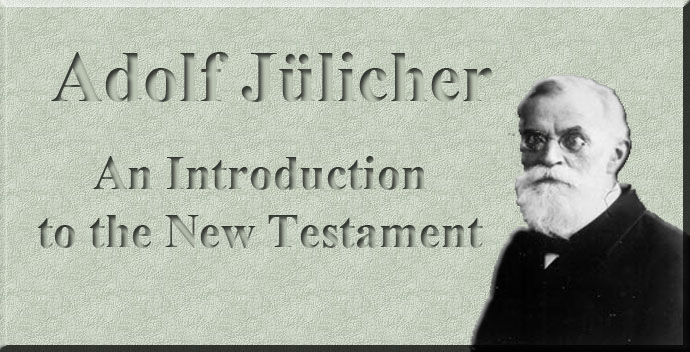
An Introduction to the New Testament
By Adolf Jülicher
PART ONE - Book III
Chapter 2 - Section 33
|
§ 33. Retrospective Survey of the Twenty-seven Books of the New Testament Everyone possessed of any religious sense must feel how much is common to all the twenty-seven books of the New Testament; but, on the other hand, this relatively small domain presents us with the greatest contrasts that it is possible to conceive. The latest of its documents are separated from the earliest by a full century; the years between 50 and 70 may have witnessed the appearance of the ten Pauline Epistles, as well as of the We-document, the Logia of Matthew and the original source of the Apocalypse, those between 70 and 100 that of the three Synoptics, Hebrews, the Apocalypse and probably, also, though only by & narrow margin, Acts and 1. Peter. Then in the beginning of the second century come the Gospel and the three Epistles of John, Jude a little later, the Pastoral Epistles probably after 125, and James and 2. Peter last of all. In bulk too, how complete is the gradation from 2. John, with its twenty-five lines or so, to Luke, more than a hundred times as long! The Epistle to Philemon is a private letter, written to an individual and intended but for a single reading, and 1. Thessalonians is the unpretending address of a pastor to his distant flock; but opposed to these we have the Apocalypse with its threats against any hearer who should injure the sacred revelation by additions or suppressions,1 and 2. Peter with its artificial means of assuring itself universal and obedient recognition. Comparison is scarcely possible between the Greek of the Apocalypse and that of Hebrews, and still less so between the mental atmospheres which surround the two. It would be impossible for two branches of literature to be more opposed to one another than those represented by the genuine Pauline Epistles and the Acts, or the Gospel of Mark and the Apocalypse. It was not so easy as we, after two thousand years of growing use, are wont to imagine, to regard the story of Jesus as told by Mark and Luke as authentic, and yet to display the same respect for a work whose claims were so wholly different as those of John. Finally, however, the mental endowments, and especially the literary capacity, of the writers with whom we are here dealing are enormously varied in degree; the well-meaning bluntness of Jude, for instance, is almost unendurable beside the profundity of Paul. And yet the Church was insensible to all these contrasts and actually put together the twenty-seven works in question, written as they were by at least twelve different authors, into one book, and treated it, moreover, from beginning to end asa single entity. The indifference of the Primitive Church as to the forms in which she possessed and handed down her most sacred writings (for none of her members intended to exercise any creative faculty in this respect, or to introduce a new genre into literature) certainly assisted such a process; nevertheless, considering the immense amount of difficulties to be overcome, it was accomplished in a marvellously short time. It will now be our task to ascertain the guiding forces behind this process, the actual motives which led to the collection and canonisation of the twenty-seven Books of the New Testament.
|
|
 |
 |
|
1) xxii, 18 and 19.
|
|
-
Site Navigation
 Home
Home What's New
What's New Bible
Bible Photos
Photos Hiking
Hiking E-Books
E-Books Genealogy
Genealogy Profile
Free Plug-ins You May Need
Profile
Free Plug-ins You May Need
 Get
Java
Get
Java.png) Get Flash
Get Flash Get
7-Zip
Get
7-Zip Get Acrobat Reader
Get Acrobat Reader Get
TheWORD
Get
TheWORD